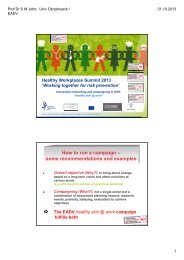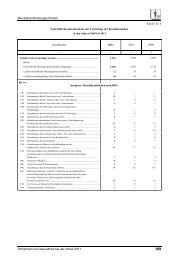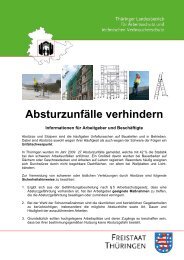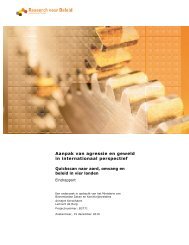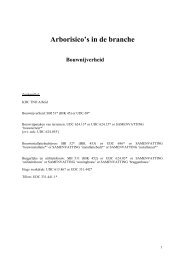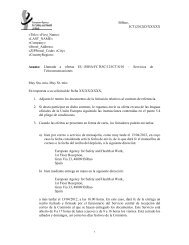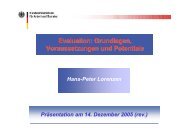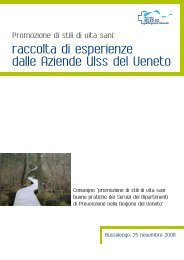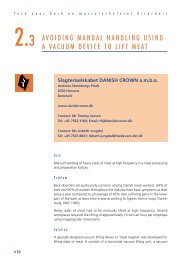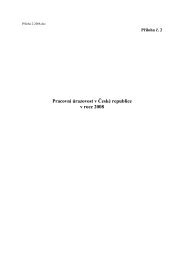ESENER-PSR 2009 - European Agency for Safety and Health at Work
ESENER-PSR 2009 - European Agency for Safety and Health at Work
ESENER-PSR 2009 - European Agency for Safety and Health at Work
You also want an ePaper? Increase the reach of your titles
YUMPU automatically turns print PDFs into web optimized ePapers that Google loves.
such as the French SIRENE directory are still classified according to n<strong>at</strong>ional systems (here:<br />
the French NAF codes).<br />
Nevertheless, none of these altern<strong>at</strong>ive n<strong>at</strong>ional or intern<strong>at</strong>ional codes presented problems<br />
regarding the sampling <strong>and</strong> weighting of the <strong>ESENER</strong> since all these altern<strong>at</strong>ive systems of<br />
codific<strong>at</strong>ion are well adaptable to NACE. There is not always a 100%-congruency with NACE,<br />
but existing differences are confined to very fine levels of classific<strong>at</strong>ion (third or fourth digit of<br />
NACE). In the new NACE version, comp<strong>at</strong>ibility of these altern<strong>at</strong>ive systems of codific<strong>at</strong>ion<br />
has even further improved.<br />
A more problem<strong>at</strong>ic issue will be the codific<strong>at</strong>ion of addresses taken from either the Yellow- or<br />
the White-Pages telephone books or other address-bases which are based on telephoneregisters.<br />
Such registers were used in a couple of countries <strong>for</strong> addresses of the Public Sector.<br />
For these establishments of NACE Rev. 1.1. L / Rev. 2 O, the Yellow- or White-Pages entries<br />
(with topics such “municipalities”, “police-st<strong>at</strong>ions” or the like) had to be converted manually<br />
into NACE-codes.<br />
The congruency of the sectors of activity contained in the various address-sources with the<br />
NACE-codific<strong>at</strong>ion is extremely important <strong>for</strong> this survey, as it was decided not to integr<strong>at</strong>e any<br />
question about the kind of activity carried out in the surveyed establishments. Instead, the<br />
codes of activity as contained in the address-sources had to be added to the questionnaires.<br />
This procedure saved valuable interviewing time <strong>and</strong> can in most cases be supposed to be<br />
more accur<strong>at</strong>e than asking a lengthy <strong>and</strong> difficult question about the establishments’ type of<br />
activity to the respondents.<br />
While the comp<strong>at</strong>ibility of the altern<strong>at</strong>ive classific<strong>at</strong>ion systems with NACE is unproblem<strong>at</strong>ic,<br />
the most recent revision of the NACE codific<strong>at</strong>ion itself constituted a major challenge <strong>for</strong> the<br />
sampling <strong>and</strong> weighting of the <strong>ESENER</strong>: Until the end of 2007, the NACE code had been<br />
applied in its first revision of 1990 (NACE Rev. 1). Since 1 st January 2008, however, a new<br />
NACE version (NACE Rev. 2) has come into effect which significantly differs from the <strong>for</strong>mer<br />
version NACE Rev. 1 even on the 1-digit level.<br />
The n<strong>at</strong>ional st<strong>at</strong>istical offices of the EU member st<strong>at</strong>es are obliged to use the new NACE<br />
version since the beginning of 2008 <strong>for</strong> a series of official economic st<strong>at</strong>istics. Business<br />
address registers <strong>and</strong> st<strong>at</strong>istics on the distribution of establishments by sectors of activity have<br />
however often not yet been adapted to the new NACE classific<strong>at</strong>ion.<br />
25



